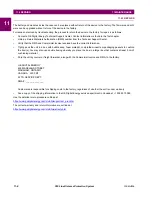
GE Multilin
D30 Line Distance Protection System
B-1
APPENDIX B
B.1 MODBUS RTU PROTOCOL
B
APPENDIX B MODBUS COMMUNICATIONSB.1MODBUS RTU PROTOCOL
B.1.1 INTRODUCTION
The UR-series relays support a number of communications protocols to allow connection to equipment such as personal
computers, Remote Terminal Units (RTUs), SCADA masters, and programmable logic controllers. The Modicon Modbus
protocol is the most basic protocol supported by the UR. Modbus RTU is available via the RS232 and RS485 serial links,
and Modbus TCP/IP is available over Ethernet. The following description is intended primarily for users who want to
develop their own master communication drivers. Note that:
•
The UR always acts as a slave device, meaning that it never initiates communications; it only listens and responds to
requests issued by a master computer.
•
A subset of the Modbus RTU and Modbus TCP/IP protocol format is supported that allows extensive monitoring, pro-
gramming, and control functions using read and write register commands.
B.1.2 PHYSICAL LAYER
The Modbus RTU protocol is hardware-independent so that the physical layer can be any of a variety of standard hardware
configurations including RS232 and RS485. The relay includes a faceplate (front panel) RS232 port and rear terminal
RS485 port. Data flow is half-duplex in all configurations. See chapter 3 for details on communications wiring.
Each data byte is transmitted in an asynchronous format consisting of 1 start bit, 8 data bits, 1 stop bit, and possibly 1 parity
bit. This produces a 10 or 11 bit data frame. This can be important for transmission through modems at high bit rates (11 bit
data frames are not supported by many modems at baud rates greater than 300).
The faceplate RS232 port is for local use and is fixed at 19200 bit/s baud and even parity. The rear terminal RS485 port can
be set for baud rates of 300, 1200, 2400, 4800, 9600, 14400, 19200, 28800, 33600, 38400, 57600, or 115200 bps, and
even, odd, and no parity options are available. See the
Communications
section of chapter 5 for further details.
The Modbus TCP/IP protocol is available on each of the rear Ethernet ports. Depending on the relay's order code, these
ports can be 10/100Base-TX or 100Base-FX.
B.1.3 DATA LINK LAYER
Modbus RTU communications takes place in packets which are groups of asynchronously framed byte data. The master
transmits a packet to the slave and the slave responds with a packet. The following describes general format for both trans-
mit and receive packets. For exact details on packet formatting, refer to subsequent sections describing each function
code.
•
SLAVE ADDRESS:
This is the address of the slave device that is intended to receive the packet sent by the master
and to perform the desired action. Each slave device on a communications bus must have a unique address to prevent
bus contention. All of the relay’s ports have the same address which is programmable from 1 to 254; see chapter 5 for
details. Only the addressed slave will respond to a packet that starts with its address. Note that the faceplate port is an
exception to this rule; it will act on a message containing any slave address.
A master transmit packet with slave address 0 indicates a broadcast command. All slaves on the communication link
take action based on the packet, but none respond to the master.
•
FUNCTION CODE:
This is one of the supported functions codes of the unit which tells the slave what action to per-
form. See the
Supported Function Codes
section for complete details. An exception response from the slave is indi-
cated by setting the high order bit of the function code in the response packet. See the
Exception Responses
section
for further details.
Table B–1: MODBUS RTU PACKET FORMAT
DESCRIPTION
SIZE
SLAVE ADDRESS
1 byte
FUNCTION CODE
1 byte
DATA
N
bytes
CRC
2 bytes
DEAD TIME
3.5 bytes transmission time
Summary of Contents for D30D00HCHF8AH6AM6BP8BX7A
Page 10: ...x D30 Line Distance Protection System GE Multilin TABLE OF CONTENTS...
Page 374: ...5 248 D30 Line Distance Protection System GE Multilin 5 10 TESTING 5 SETTINGS 5...
Page 398: ...6 24 D30 Line Distance Protection System GE Multilin 6 5 PRODUCT INFORMATION 6 ACTUAL VALUES 6...
Page 410: ...7 12 D30 Line Distance Protection System GE Multilin 7 2 TARGETS 7 COMMANDS AND TARGETS 7...
Page 444: ...9 24 D30 Line Distance Protection System GE Multilin 9 5 FAULT LOCATOR 9 THEORY OF OPERATION 9...
Page 576: ...B 102 D30 Line Distance Protection System GE Multilin B 4 MEMORY MAPPING APPENDIX B B...
Page 616: ...D 10 D30 Line Distance Protection System GE Multilin D 1 IEC 60870 5 104 PROTOCOL APPENDIX D D...
Page 628: ...E 12 D30 Line Distance Protection System GE Multilin E 2 DNP POINT LISTS APPENDIX E E...
Page 636: ...F 8 D30 Line Distance Protection System GE Multilin F 3 WARRANTY APPENDIX F F...
Page 646: ...x D30 Line Distance Protection System GE Multilin INDEX...
















































